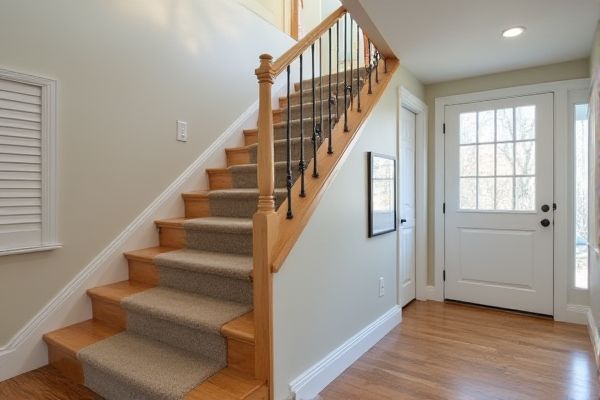
Louvered stairs offer enhanced ventilation and a modern aesthetic, making them ideal for spaces requiring airflow, while solid stairs provide a more traditional appearance with increased privacy and sound insulation. Discover how each option can impact Your home's style and functionality by reading the rest of the article.
Table of Comparison
| Feature | Louvered Stairs | Solid Stairs |
|---|---|---|
| Design | Open, slatted steps allowing light and air flow | Closed, solid steps with full surface coverage |
| Visibility | Partially see-through, enhances openness | Opaque, blocks view between steps |
| Air Circulation | Improved airflow | Limited airflow |
| Lighting | Allows natural light passage | Blocks light, requires additional lighting |
| Safety | Requires careful design to prevent tripping | Typically safer with solid surface |
| Material Usage | Uses less material, lighter weight | Uses more material, heavier |
| Cost | Generally lower material cost | Potentially higher due to materials and labor |
| Maintenance | Easier to clean, less accumulation of debris | More prone to dirt accumulation, harder to clean |
| Applications | Modern designs, outdoor and industrial settings | Traditional, residential, and commercial spaces |
Introduction to Louvered and Solid Stairs
Louvered stairs feature slatted designs that enhance air circulation and light flow, ideal for modern and open-concept spaces. Solid stairs provide a continuous, sturdy surface offering greater privacy and noise reduction, commonly used in traditional or enclosed interiors. Both stair types serve distinct aesthetic and functional purposes, influencing architectural style and spatial dynamics.
Louvered Stairs: Definition and Key Features
Louvered stairs feature horizontal slats or fins, known as louvers, which allow light and air to pass through while providing a modern and open aesthetic. These stairs are often made from wood, metal, or composite materials, combining functionality with a sleek, contemporary design that enhances ventilation and visibility. Key features include improved airflow, reduced visual bulk, and customizable spacing options that balance privacy with openness.
Solid Stairs: Definition and Key Features
Solid stairs consist of fully enclosed risers, creating a sturdy and traditional structure that enhances safety and privacy by preventing visibility between steps. These stairs often feature materials such as hardwood, concrete, or metal, providing durability and a sense of permanence in both residential and commercial settings. Your choice of solid stairs ensures a classic aesthetic and solid support, making them ideal for high-traffic areas where structural integrity is paramount.
Design Aesthetics: Louvered vs Solid Stairs
Louvered stairs offer a contemporary and lightweight design aesthetic with open slats that create visual transparency and allow light to flow through, enhancing modern architectural spaces. Solid stairs, by contrast, provide a more traditional and robust appearance with continuous risers, delivering a sense of permanence and structural solidity. The choice between louvered and solid stairs significantly impacts spatial perception, with louvers promoting openness and solids emphasizing formality and enclosure.
Ventilation and Airflow Benefits
Louvered stairs enhance ventilation and airflow by allowing air to pass freely through the open slats, reducing moisture buildup and promoting better indoor air quality. Solid stairs, in contrast, obstruct airflow, potentially causing stagnant air and increased humidity levels in enclosed spaces. Optimal airflow from louvered stairs can improve temperature regulation and contribute to a healthier living environment.
Privacy and Security Considerations
Louvered stairs provide reduced visibility between steps, enhancing privacy by limiting sightlines compared to solid stairs. However, solid stairs offer greater security as they prevent objects or individuals from passing through gaps, reducing risks of climbing or falling hazards. Selecting between louvered and solid stairs depends on balancing the need for visual privacy with safety and security requirements in residential or commercial settings.
Durability and Maintenance Requirements
Louvered stairs feature slats that allow air circulation but may accumulate dust and require frequent cleaning to maintain appearance, while solid stairs offer greater durability due to their continuous surface that resists wear and requires less upkeep. Your choice depends on preference for ventilation versus ease of maintenance, with solid stairs generally providing longer-lasting performance in high-traffic areas. Both types benefit from materials like treated hardwood or metal to enhance durability and reduce maintenance demands.
Cost Comparison: Louvered vs Solid Stairs
Louvered stairs typically cost more than solid stairs due to their intricate design and the use of additional materials for the louvers, which increases manufacturing and installation expenses. Solid stairs offer a more budget-friendly option, with lower material and labor costs, making them a popular choice for cost-conscious projects. Homeowners and builders should weigh the aesthetic appeal and ventilation benefits of louvered stairs against the affordability and durability of solid stairs when making a decision.
Popular Applications and Use Cases
Louvered stairs are popular in modern architectural designs, offering enhanced ventilation and a lightweight aesthetic ideal for outdoor decks, rooftop terraces, and industrial spaces. Solid stairs provide durability and a classic appearance, making them suitable for high-traffic commercial buildings, residential homes, and interior staircases requiring noise reduction and increased safety. Your choice between louvered and solid stairs depends on whether ventilation, style, or sturdiness best fits your specific application.
Choosing the Right Stair Type for Your Space
Louvered stairs offer enhanced airflow and a modern aesthetic, ideal for spaces requiring ventilation and light penetration, while solid stairs provide a more traditional look with added privacy and noise reduction. Consider factors such as room size, intended use, and design style when choosing between these stair types to optimize both functionality and visual appeal. Proper measurement and material selection also ensure durability and safety tailored to your specific environment.
 homyna.com
homyna.com